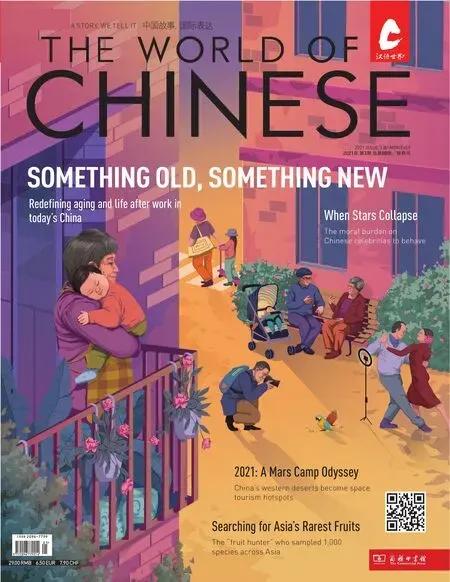SHARDS OF HISTORY
-BY TINA XU (徐盈盈)
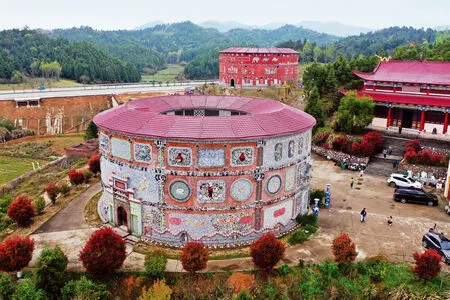
In the world’s porcelain capital, artisans try to bring one of China’s hottest historical commodities into the 21st century
千年瓷都如何再续传奇?
At 81, against the wishes of her family, Yu Ermei took her life savings and built a palace: Two giant rotundas covered from floor to ceiling in glassy porcelain shards, rising four stories tall like mirages in the fields outside of Jingdezhen, the town where she had lived and worked all her life.
That was more than ten years ago.On a cloudy spring morning, wearing a padded cotton jacket and cloth shoes,91-year-old Grandma Yu’s walking stick clinks over the mosaic floors as she shows TWOC around the palace grounds: “I told my kids I’d disown them if they dared to stop me! I don’t know if the local government will tear it down after I die,” she says.“But nobody could stop me from doing it.”
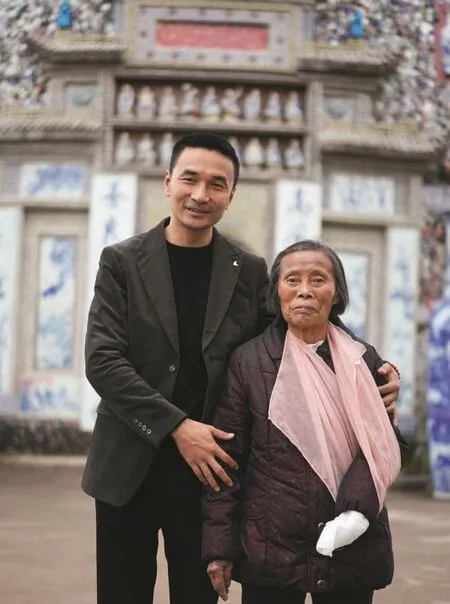
Yu Ermei spent 6 million RMB to build a porcelain palace on the outskirts of Jingdezhen
Grandma Yu left elementary school to apprentice in a porcelain workshop at the age of 12, after her father passed away.Over decades, she mastered
molding, painting, and kiln firing in the style offamille roseat Hongguang Porcelain Factory.Two decades into retirement, she stubbornly embarked on her magnum opus.She introduces a hall of portraits of 100 Chinese emperors painted on porcelain,followed by Lenin and Mao: a century of vogue fused into one building.
“Artists are the bridges between past and future,” declared writer and porcelain connoisseur Wang Kai at a public forum on ceramics in Beijing last December.“Perhaps making a porcelain cup is not hard.But what I am thinking when I make it—what you are thinking when you use it—this possibility of dialogue is the starting point of beauty.”
Jingdezhen, in China’s central Jiangxi province, is a city of such starting points.For a thousand years,its wares have been shipped across the world to adorn tables from Lisbon to Dara’a, Cairo to North Carolina,serving as global vessels for personal obsession and national ambition.Today, residents of the “Porcelain Capital of the World” battle to mold the art into the 21st century as the place and craft continue to evolve in unpredictable directions.
True porcelain—as distinguished from regular pottery by its durability and glass-like surface—was first invented in the 9th century, a Chinese secret carefully guarded for hundreds of years.For centuries, Jingdezhen was ground zero of porcelain production,firing its kilns to order for Chinese emperors, Persian caliphs, European kings, and American tycoons.In many languages, the very name of fine porcelain is identical to its country of origin: china.
Yu Lingde of Dongbu village,upstream of downtown Jingdezhen,remembers sitting on his father’s boat as the workers transported minerals into the city.“The journey used to take an entire week.The river was alive with boats, and the noise of unloading at the docks,” he recalled.“That time isn’t coming back.”
These days only birdsong can be heard in the surrounding Gaoling Mountains, riddled with abandoned tunnels that miners stretched for kilometers in their pursuit of kaolin,a white mineral named after the mountain range.This is porcelain’s secret ingredient.Around 800 CE,a craftsman from the city discovered that if kaolin is added to a block of petuntse (powdered minerals used for making clay), and then fired up to 1,450 degrees Celsius, it forms a translucent substance that is exceptionally strong.If petuntse is theflesh of porcelain, then kaolin is the bone.
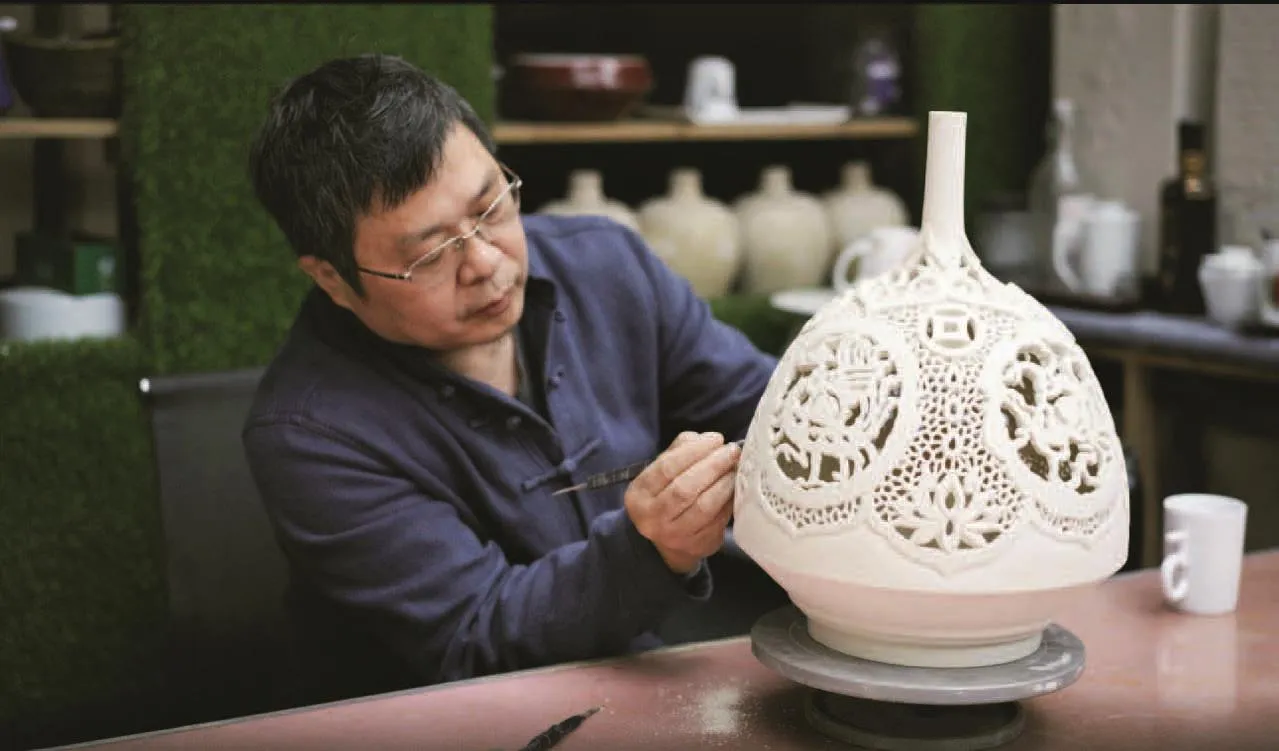
Linglong porcelain is a style of translucent porcelain that emerged in Jingdezhen in the Ming dynasty
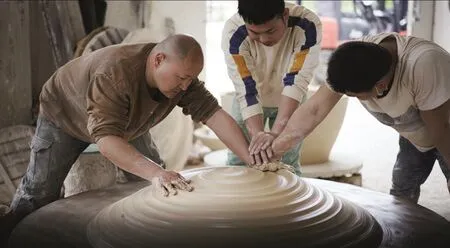
A 1.8-meter wide bowl takes three workers over an hour to shape in a factory specializing in supersized porcelain

“Steamed bun” kilns were commonly used in the plains of the north, while long and winding “dragon” kilns were used in the mountainous south
According to imperial records,when Emperor Shizong of the Later Zhou dynasty (951-960) caught wind of such a material “clear as the sky, bright as a mirror, thin as paper,and resonant as a musical stone,”he appropriated the mines around present-day Jingdezhen to supply royalty exclusively.In 1004, Emperor Zhenzong of the Song dynasty(960-1279) ordered the building of major imperial kilns in the town then known as Fude, and renamed it after his own era name, Jingde.In 1433,a single order from the Xuande Emperor of the Ming (1368-1644)called for 443,500 porcelain pieces with dragon and phoenix designs.
Chinese porcelain first made its way to Persia and the Middle East in the 9th century, then to Europe in the 14th century allegedly via Marco Polo.Around the same time, Jingdezhen artisans became impressed by the vividness of Persian cobalt, which they called “Muslim blue,” and began importing it.Few other pigments could withstand the high temperatures of porcelain firing, a complication that had restricted the color palette of china for centuries.
With cobalt, a new style of Chinese porcelain was born, and by far the best-known today:qinghua, or blueand-white, eclipsing the then-popular greenish-whiteqingbaiwares.During the Ming dynasty, the Jingdezhen imperial kilns developedwucai, or the “five ancient pigments” of red,yellow, green, blue, and purple.By the Qing dynasty (1616-1911),the pastel and ornamentalfencai, orfamille rose, came into vogue.
At its height in the 18th century,Jingdezhen employed over a million men, women, and children in over 3,000 kilns.The manufacturing process branched into dizzying levels of specialization, spanning 72 professions.Each workshop required six decorators specializing in arts such as pattern-drawing and carving; three people to pack and transfer porcelain along various stages of production;three specialized workers to fire the kilns and sweep the ash; and dozens of others for jobs like claycompounding and oxide-grinding.
The rocks were brought down from the mines to the foothills,where water-powered pestles three meters tall rose and fell, pulverizing the stone.The Ming official Wang Shimao wrote in 1576 that “the noise of tens of thousands of pestles thundering in the ground and the heavens alight with the glare from the fires kept me awake all night.” The stone pathways of Dongbu village still bear the tracks of wheelbarrows carting the minerals down to the docks, the wheels carving deep rivets into the stone over the years.
In China today, porcelain carries another kind of fantasy.In the studio district of Jingdezhen, 30-year-old Xing Yi comes into his workshop around noon, and leaves around midnight—or later, if his friends come by with drinks.In between, he makes pottery, chats, and drinks half a dozen pots of tea a day, with his dog Laifu weaving between his feet.
“Thisis real life,” he says emphatically, putting another pot of water to boil.
Born in Inner Mongolia, Xingmoved to Beijing after university for work, but quit five years ago to move to Jingdezhen.Known asJingpiao, or“Jingdezhen drifters,” an estimated 30,000 people like Xing have migrated here from across China and the world to make pottery.For escapees of the urban grind, porcelain has become a lifestyle: slow, deliberate handiwork to offset the abstraction, alienation, and pressures of modern life.

Machines now replace much of Jingdezhen’s ancient process of porcelain-making
It is estimated that around half of Jingdezhen’s population is employed in pottery-related work.However,most local workshops have abandoned the kaolin of the nearby mountains for purer deposits in Fujian and Hebei provinces.Porcelain wares are cheaply mass-produced in factories in Guangdong, Fujian, and other provinces, where patterns are not hand-painted but applied by sticker.The heyday of Jingdezhen’s handcrafted pottery workshops, known throughout imperial times for their elaborate craftsmanship, are a thing of the past.
What remains is the aura of history,the prestige of being the porcelain capital of the world, a smattering of boutique potters whose handcrafted porcelain can sell for millions of RMB per teapot, and a generation of young bohemian potters who carry on the craft.
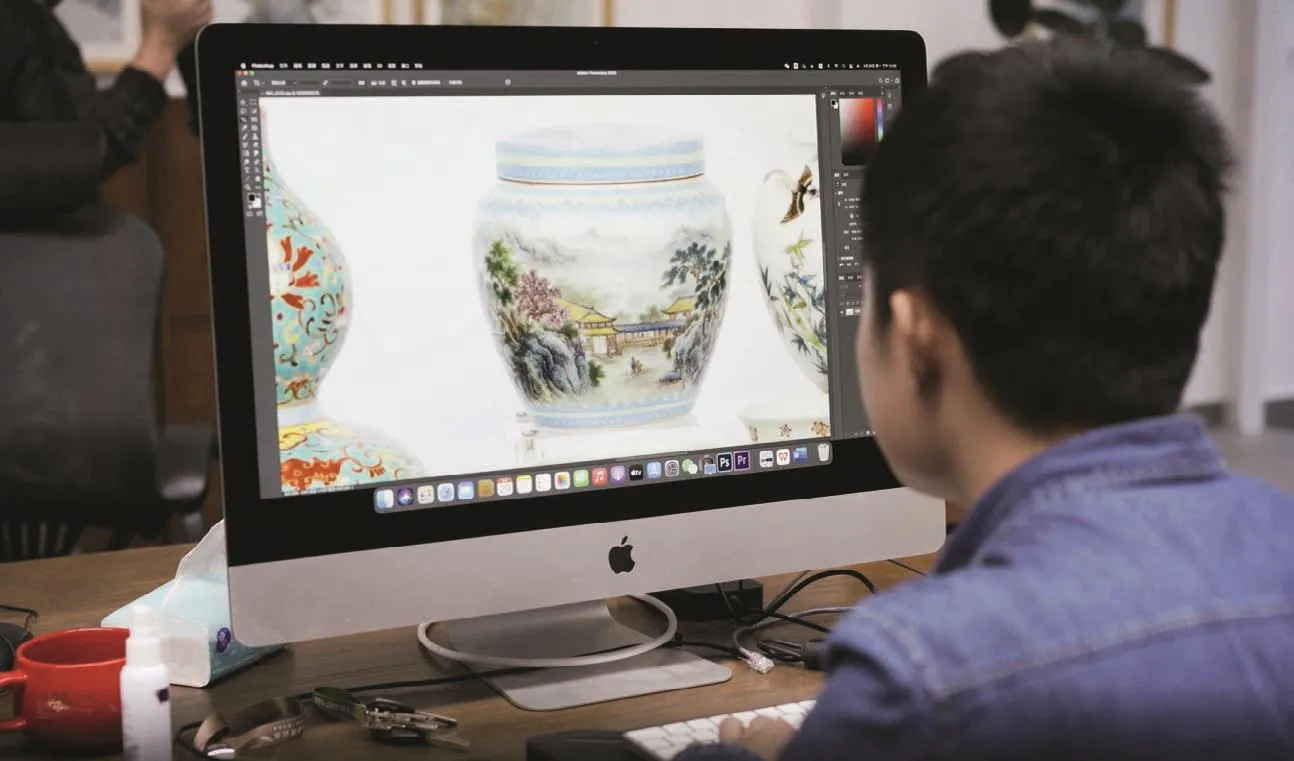
Digitaldesign is now one of the majors at the Jingdezhen Ceramics Institute as porcelain production enters the 21st century
Unable to compete with mass production, Jingdezhen residents are attempting to upgrade from selling their wares to selling their craft and lifestyle.Yu Lingde, whose father once transported kaolin by boat, now rows his family’s bamboo raft for tourists visiting his village to see the bronze statues and plaques describing the ancient process of loading on the docks.
Dong Quanbin, aJingpiaowhose teacups go for thousands of RMB each, sells the idea of the cup as much as the cup itself: “A tool like a cup is not a piece of art.It’s when you criticize and examine it—that’s when it becomes art,” he mused at a public lecture last December in Beijing to publicize his bookYirenyin,a compilation of meditations on tea vessels.“In history, vessels were used to make offerings to spirits.The beauty of tea ware comes from its qualities of experience for humans.”
In the 2010s, the market for luxury porcelain mushroomed, convincing some young people that they could
make a living by moving to Jingdezhen and taking up pottery.However, that bubble burst by the middle of the decade.Artists have not reduced their prices, but the volume of sales has declined.Many are packing up shop and leaving altogether.
Meanwhile, artists in Jingdezhen search for new aesthetics amidst the rubble of the old—literally.The glutted banks of the Chang River carry a millennium of porcelainmaking in its soil.After storms clear—or when an old neighborhood is demolished in construction projects—white-edged pieces of broken pottery from a potpourri of centuries poke out of the mud and glisten at the bottom of streams.Locals sift through the earth for shards of ancient pottery to sell at antique markets.
When Cai Wenjuan was a teenager,she would join the hunt.“At this point, it’s rare to find anything,” Cai,aqinghuapottery painter, admits,“unlike the past, when people would dump buckets of old shards into the river.” These days, Cai scours for interesting pieces in the city’s “ghost markets” on Sunday mornings,where hawkers bring complete and incomplete porcelain pieces to sell before sunrise.Some pottery from the Ming and Qing dynasties go for hundreds of RMB.
A Jingdezhen native, Cai attended the Jingdezhen Ceramic Institute,the country’s only institute of higher learning dedicated to ceramics; 19,000 students are enrolled in subjects as diverse as archaeology, materials chemistry, art practice, and ceramics research.Cai chose to carry on her father and grandfather’s craft of blueand-white painting, a skill in which one pigment is diluted into over 20 different shades, taking years to master the mixing and linework.
Cai has passed theory and performance tests to become certified by the city as an official inheritor ofqinghuapainting skills, an “intangible cultural heritage,” in an initiative to encourage young people to carry on traditional crafts.Jingdezhen has certified over 1,000 city-level inheritors in skills as varied as ceramics calligraphy, carving, hightemperature color-glaze painting, and seal making.
“There are not many young people who study ancient painting techniques,because the process of painting is very long,” says Li Jieming, another certified inheritor of the “intangible cultural heritage” ofwucaipainting.“You can sit down to do one [piece],and two or three years pass by quietly.Young people want things to happen fast.”
These days, Cai doesn’t just make bowls and vases—she also makes blue and white-inspired jewelry and bags,including a collection of eco-friendly totes designed from florid porcelaininspired patterns.Her boutique, China Story, is popular among local and tourist customers in their 20s and 30s,who are more likely to buy culturallyinspired clothes and accessories than luxurious teapots and vases.
Young porcelain artists are taking Chinese porcelain in new styles and directions.Under the eaves of his open-air studio, Jingdezhen-born Wang Yimin displays his awardwinning slates of sunflowers in bright yellows, rich browns, and deep greens.They cover the two-meter-high porcelain tableau like an oil painting,abandoning the notion of negative space and color restraint once crucial to Chinese aesthetics.Bright, striking pigments flow to each corner of his hard, shining canvas.

Cai Wenjuan passed a municipal certification test for blue-and-white painting
Modern chemistry has created synthetic pigments that can withstand high-temperature firing.Just as cobalt expanded the visual vocabulary of Jingdezhen ceramics in the 14th century, today there are pigments created for every color and shade imaginable, explains Wang.
Yet such new methods require experimentation.In Wang’s rented studio, he recalls that for a series of 12 tableaus, he ruined at least 40 specimens in the firing stage.“The kiln is filled with uncertainty.When the heat and glaze achieve perfect harmony, works emerge from the fire like a phoenix.I felt I had found a new aesthetic language,” he says.
While technology enables new kinds of expression, it also forces the maker’s hand.Previously, a perfectly proportional teacup with no pockmarks was a difficult achievement, but machines now churn them out by the millions.Artists like Dong have changed tack, making minimalistic and iconoclastic cups.Some feature black pockmarks that once would have been thrown out as defective.
As porcelain continued to evolve, so has the town.“Urbanism is efficient,but now, everything looks the same,even Jingdezhen,” Dong laments.Yet beneath Jingdezhen’s conventional urban appearance, handfuls of studios still house an eclectic mix of young artisans.They quietly continue the legacy of Jingdezhen’s fabled potters from the shade of their studios,creating new styles that provide a gleaming mirror to the times.
“Darwin put forward a theory of change,” says Dong.“If a bird species changes, the bugs and trees will change in response.”

